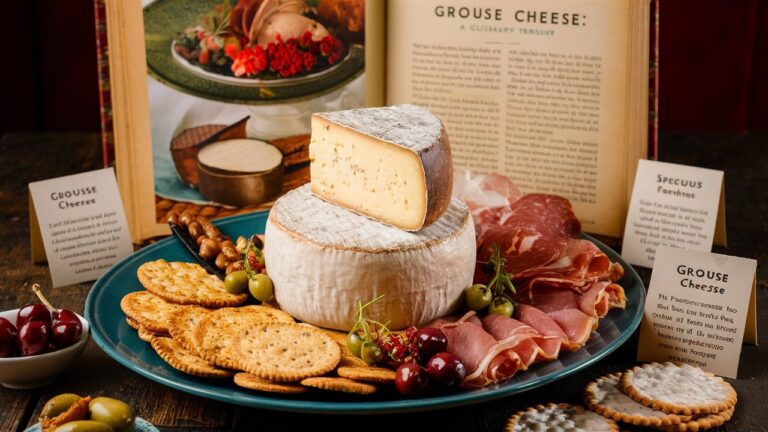Introduction
The world of gourmet food is filled with surprising discoveries, where traditional ingredients meet in unexpected ways to create unique culinary experiences. One such fascinating concept is grouse cheese. At first glance, the phrase may sound unusual, even puzzling, but it represents a bold exploration of flavors by combining the richness of game meat like grouse with the creamy depth of fine cheeses. Whether understood as a literal infusion of cheese with grouse flavor, or more commonly as a gourmet pairing of roasted grouse served alongside artisanal cheeses, this culinary creation has become a topic of interest among food enthusiasts, chefs, and curious diners who crave something beyond the ordinary.
The Origins of Grouse Cheese
The term “grouse cheese” does not refer to a single standardized product like cheddar or brie. Instead, it has roots in culinary experimentation, particularly within European fine dining. Grouse, a game bird prized for its rich, earthy flavor, has long been a delicacy in countries like Scotland, France, and Scandinavia. Cheeses, on the other hand, have been staples of European food culture for centuries, valued for their wide spectrum of flavors, textures, and aromas. Over time, chefs began to explore ways to pair game meats with cheeses, creating what could be described as “grouse cheese” experiences—whether through cheese sauces, infused spreads, or thoughtfully designed tasting menus. This fusion highlights the evolving nature of gastronomy, where creativity often pushes the boundaries of tradition.
Flavor Profile: What Grouse and Cheese Bring Together
The appeal of grouse cheese lies in the harmony of two very different but complementary flavor families. Grouse meat is known for its deep, slightly gamey taste, often compared to wild duck or pheasant, but with a more intense earthy undertone. When combined with cheese, especially varieties that are creamy, nutty, or slightly sharp, the flavors balance each other in surprising ways. For instance, a rich brie can soften the strong notes of grouse, while a tangy blue cheese can elevate its complexity. In some experimental kitchens, chefs even create spreads or terrines that incorporate both grouse and cheese, resulting in a distinctive delicacy unlike anything found in mainstream dining.
Culinary Uses of Grouse Cheese
The use of grouse cheese—or more precisely, grouse and cheese pairings—has found a place in several areas of fine dining:
-
Tasting Menus: High-end restaurants may serve roasted grouse breast alongside aged cheeses as part of multi-course meals, showcasing the interplay of textures and flavors.
-
Cheese Boards with Game Accents: Some charcuterie boards now include game-based spreads or pâtés infused with cheese, offering diners an exotic twist on a classic presentation.
-
Sauces and Accompaniments: Chefs may create creamy cheese sauces to serve with grouse, blending richness with savory depth.
-
Experimental Fusion Cuisine: In modern gastronomy, grouse and cheese combinations symbolize the willingness of chefs to break tradition and present guests with something memorable.
These applications highlight how grouse cheese is less about a rigid product and more about a flexible culinary idea that continues to evolve.
Cultural Significance of Grouse Cheese
Beyond flavor, grouse cheese also symbolizes the cultural blending of luxury food traditions. In Scotland, grouse has long been celebrated as a seasonal game bird, hunted during the famous “Glorious Twelfth” (the start of the grouse hunting season each August). Meanwhile, Europe’s cheese-making heritage stretches back centuries, representing some of the most cherished artisanal crafts in gastronomy. Bringing the two together, whether literally or symbolically, creates a narrative of heritage, exclusivity, and creativity. Food culture thrives on stories, and grouse cheese tells one of innovation and indulgence.
Why Food Enthusiasts Seek Out Grouse Cheese
The allure of grouse cheese is not simply about taste but about the experience of discovery. In an era where food lovers are constantly searching for new sensations, grouse cheese represents the kind of culinary curiosity that makes dining memorable. For some, it is the appeal of trying something rare and luxurious. For others, it is about celebrating the artistry of chefs who dare to combine ingredients in unexpected ways. This curiosity explains why grouse cheese has begun to appear more frequently in culinary conversations, food blogs, and even experimental recipes shared online.
Conclusion
While it may not be a household name like cheddar or mozzarella, grouse cheese occupies a unique place in the world of gourmet food. It represents the union of tradition and experimentation—bringing together the earthy richness of grouse with the creamy or tangy depth of artisanal cheeses. More than just a food, it is an idea that reflects creativity, cultural heritage, and the human desire to explore flavors beyond the ordinary. For food enthusiasts, gourmets, and adventurous diners, grouse cheese offers not just a taste, but a story worth experiencing.
FAQ (Frequently Asked Questions)
Q1: What is grouse cheese?
Grouse cheese generally refers to the culinary pairing of grouse (a game bird) with cheese, or in some cases, experimental spreads and sauces that combine the two.
Q2: Does grouse cheese exist as a standalone product?
Not in the way traditional cheeses do. It is more of a gourmet concept involving grouse and cheese served together or infused in recipes.
Q3: What does grouse cheese taste like?
The flavor combines the earthy, gamey richness of grouse with the creamy, nutty, or sharp qualities of cheese, resulting in a unique harmony.
Q4: Where is grouse cheese most popular?
It is primarily found in European fine dining, especially in places where grouse hunting is part of tradition, such as Scotland and France.
Q5: Can I make grouse cheese at home?
Yes. While you may not find it in stores, you can create your own version by preparing roasted grouse and pairing it with complementary cheeses like brie, gouda, or blue cheese.What Is Grouse Cheese? Flavor, History, and Gourmet Pairings
